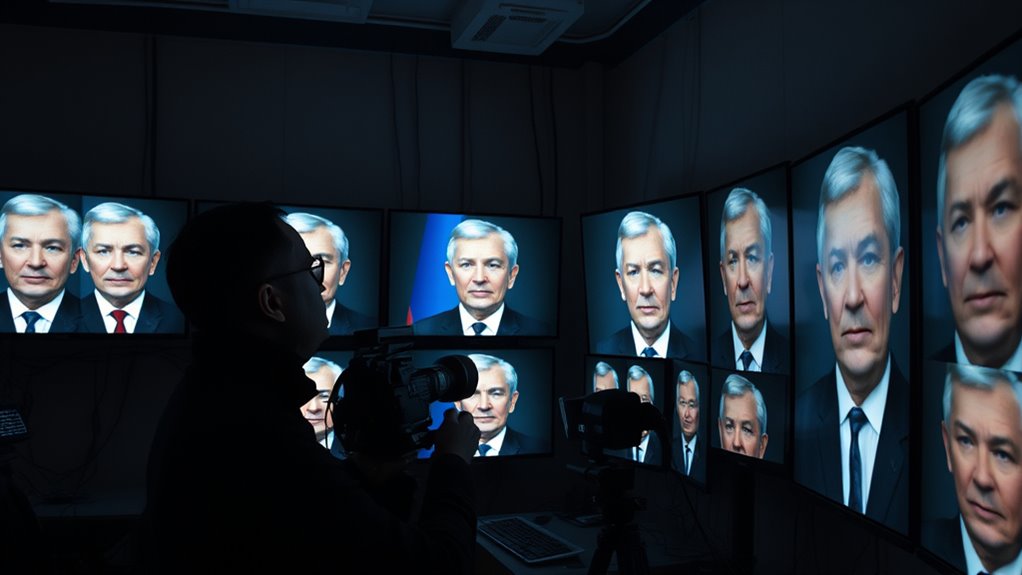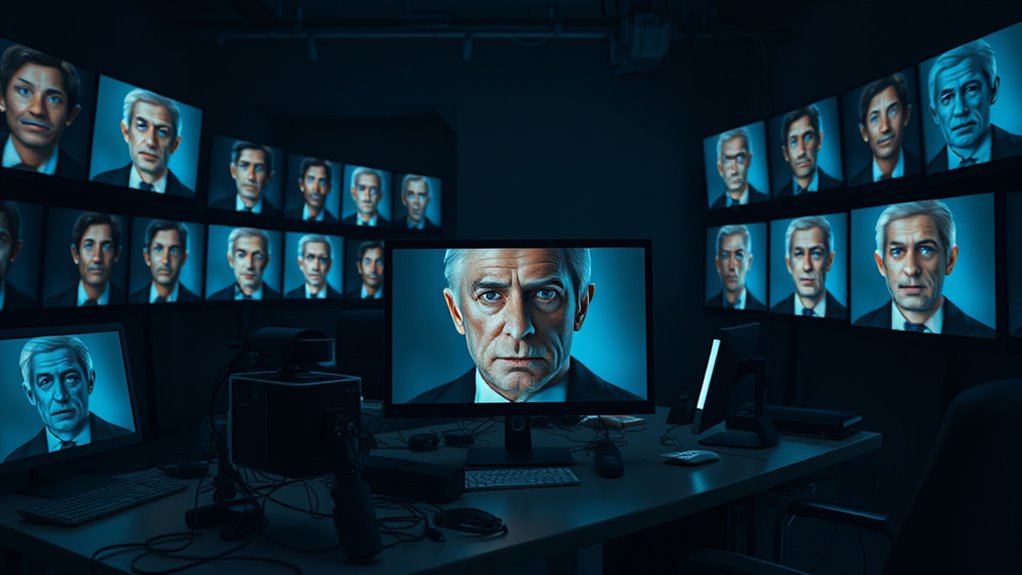Russia's SVR has been using deepfake technology to impersonate U.S. diplomats online, which poses a serious threat to international relations. These AI-generated videos can mislead the public and disrupt diplomatic ties, creating chaos and confusion. As misinformation proliferates, it's harder for people to distinguish between fact and fiction. The rapid advancements in this technology highlight the urgent need for effective detection methods and regulations to combat such manipulative tactics. There's much more to uncover regarding these implications.
Key Takeaways
- The Russian Foreign Intelligence Agency (SVR) utilizes deepfake technology to create deceptive content impersonating U.S. diplomats online.
- Deepfakes are employed to manipulate information and sway public perception during geopolitical conflicts.
- Instances of fake videos featuring political figures have been reported, generating confusion and misinformation.
- Advanced detection technologies are being developed, but the rapid evolution of deepfake creation poses significant challenges.
- Public awareness and legislative regulation are crucial to combat the misuse of deepfake technology in international relations.

In recent years, the use of deepfake technology has surged, raising alarms about its potential for manipulation in political arenas. Deepfakes, which are AI-generated content that mimics real people or scenarios, have evolved significantly, making it increasingly difficult to distinguish between what's real and what's fabricated. You might be surprised to learn that state actors, particularly in Russia, are leveraging this technology to influence public perception and international relations.
The Russian foreign intelligence agency, SVR, has been implicated in utilizing deepfakes to advance strategic goals. This isn't just a fleeting concern; the SVR reportedly combines deepfakes with traditional cyber operations to manipulate information ecosystems effectively. For instance, there have been instances of fake videos featuring Ukrainian leaders, which can sway public opinion and create discord among nations.
Imagine the chaos and confusion that such misinformation can cause, especially when it targets diplomats or political figures.
As deepfake technology proliferates, the risks associated with it multiply. You might wonder how we can combat this threat. Organizations like Sber, Russia's largest bank, are developing AI-based tools to detect deepfakes. These tools analyze micro color changes and employ advanced neural networks for accurate detection, which can enhance the accuracy of deepfake detection technologies.
However, the rapid evolution of deepfake creation tools means detection technologies must continuously adapt. This arms race between creation and detection technologies poses a significant challenge.
Public awareness plays a crucial role in mitigating the impact of deepfakes. Over half of Russians believe there should be legislative regulation surrounding deepfakes to prevent misuse. As more people become aware of the potential for manipulation, they might become more critical of the content they consume, helping to curb the influence of these deceptive technologies.
Yet, the need for international legislation is pressing, as deepfakes can have far-reaching implications beyond Russia.
Furthermore, the operational aggression displayed by Russia in using these technologies raises substantial international security concerns. While Russia may struggle with retaining talent for innovation, it has shown a willingness to exploit advanced technologies like AI and machine learning for strategic purposes.
This aggressive posture could alter diplomatic relationships and create new tensions in an already fragile global landscape.
In a world where the lines between reality and deception blur, the implications of deepfake technology extend far beyond entertainment. It's imperative that you stay informed and vigilant, recognizing the potential for manipulation in the political sphere and advocating for necessary regulations to safeguard against these threats.
Frequently Asked Questions
What Is Deepfake Technology and How Does It Work?
Deepfake technology creates realistic fake images, videos, or audio by using artificial intelligence.
It employs Generative Adversarial Networks (GANs), where one AI generates content while another evaluates it for authenticity.
You'll find deepfakes in entertainment, education, and even disinformation campaigns.
By analyzing vast datasets, deepfake algorithms manipulate facial expressions and speech patterns, making them increasingly sophisticated and challenging to detect.
Understanding how it works can help you navigate its potential risks.
How Can Individuals Protect Themselves From Deepfake Impersonation?
Deepfake dangers demand diligent defense!
To protect yourself from deepfake impersonation, stay savvy and skeptical. First, utilize AI tools to analyze content for inconsistencies. Employ multi-factor authentication, combining biometrics and passwords for added security.
Educate yourself about deepfake risks through training and awareness campaigns. Finally, verify identities by cross-checking documents against official records.
Are There Legal Consequences for Using Deepfake Technology Maliciously?
Yes, there are legal consequences for using deepfake technology maliciously. Depending on your location, state laws may criminalize certain uses, like nonconsensual pornography.
You could face civil lawsuits if you create or share deepfakes that infringe on someone's rights or use copyrighted material without permission.
Additionally, federal proposals are emerging to address these issues, so staying informed about local regulations is crucial for avoiding legal trouble.
What Are the Ethical Implications of Deepfake Technology?
Deepfake technology spreads like wildfire, igniting ethical concerns that are hard to contain.
You're faced with issues like misinformation, as false narratives can easily manipulate public opinion and erode trust.
Privacy violations occur when your likeness is used without consent, leading to psychological harm.
Moreover, the potential for reputational damage raises alarms, complicating the already fraught landscape of digital authenticity.
Ultimately, navigating these ethical implications requires vigilance and responsibility from all involved.
How Prevalent Is the Use of Deepfake Technology in Cyber Espionage?
Deepfake technology's prevalence in cyber espionage is skyrocketing.
You mightn't realize it, but cases have surged significantly, especially in the Asia-Pacific region.
Malicious actors are using deepfakes to impersonate individuals and spread disinformation, making these tactics more effective and harder to detect.
As sophistication increases, the risks to public trust and political stability grow, highlighting the urgent need for awareness and regulatory measures to combat these threats.
Conclusion
As the SVR's use of deepfake technology shows, the threat of digital impersonation is real and growing. Imagine a scenario where a deepfake of a U.S. diplomat is used to manipulate negotiations, causing international tensions to escalate. This highlights the urgent need for robust digital verification methods and awareness among diplomats and the public. Staying informed and vigilant against such tactics can help safeguard against misinformation and protect diplomatic integrity in an increasingly digital world.








